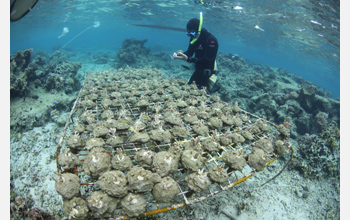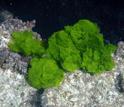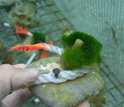News Release 10-079
Killer Seaweed: Scientists Find First Proof that Chemicals from Seaweeds Damage Coral on Contact
Downward death spiral may hit coral reefs

Scientist-sleuth Douglas Rasher checks for effects of seaweed on a coral culturing rack in Fiji.
May 10, 2010
This material is available primarily for archival purposes. Telephone numbers or other contact information may be out of date; please see current contact information at media contacts.
Chlorodesmis, it's called, this green seaweed whose filamentous fronds look like maiden's hair.
But this innocuous-appearing seaweed is a killer, scientists have discovered.
Field studies have shown for the first time that Chlorodesmis and several common species of seaweeds in both the Pacific and Caribbean Oceans can kill corals upon contact. They use chemicals to do the deed.
While competition between seaweed and coral is just one of many factors affecting the decline of coral reefs worldwide, this chemical threat may provide a serious setback to efforts aimed at repopulating damaged reefs.
A study documenting the chemical effects of seaweeds on corals was published this week in the early online edition of the journal Proceedings of the National Academy of Sciences (PNAS).
The research was supported by the National Science Foundation (NSF), the National Institutes of Health and the Teasely Endowments at the Georgia Institute of Technology.
Seaweeds are normally kept in check by herbivorous fish, according to David Garrison, director of NSF's Biological Oceanography Program, which funded the research.
But in many areas, says Garrison, overfishing has reduced the populations of these plant-consumers, allowing seaweeds to overpopulate coral reefs.
"Between 40 and 70 percent of the seaweeds we studied killed corals," said Mark Hay, a marine ecologist at Georgia Tech.
"We don't know how significant this is compared to other problems affecting coral, but we know this is a growing problem. For reefs that have been battered by human use or overfishing, the presence of seaweeds may prevent natural recovery from happening at all."
Coral reefs are declining worldwide, and scientists studying the problem had suspected that proliferation of seaweed was part of the cause--perhaps by crowding out the coral or by damaging it physically.
Using racks of coral being transplanted as part of repopulation efforts, Hay and graduate student Douglas Rasher compared the fate of corals from two different species when they were placed next to different types of seaweed common around Fijian reefs in the Pacific--and Panamanian reefs in Caribbean.
They planted the seaweeds next to coral being transplanted--and also placed plastic plants next to some of the coral to simulate the effects of shading and mechanical damage.
Other coral in the racks had neither seaweeds nor plastic plants near them.
The researchers revisited the coral two days, 10 days and 20 days later. In as little as two days, corals in contact with some seaweed species bleached and died in areas of direct contact.
In other cases, the effects took a full 20 days to appear--or for some seaweed species, no damaging effects were noted during the 20-day period.
Ultimately, as much as 70 percent of the seaweed species studied turned out to have harmful effects--but only when they were in direct contact with the coral.
To confirm that chemical factors were responsible, Hay and Rasher extracted chemicals from the seaweeds--and from only the surfaces of the seaweeds.
They then applied both types of chemicals to corals by placing the chemicals into gel matrix bound to a strip of window screen, forming something similar to a gauze bandage and applying that directly to the corals.
To a control group of corals, they applied the gel and screen without the seaweed chemicals.
The effects confirmed that chemicals from both the surface of certain seaweeds and extracts from those entire plants killed corals.
"In all cases where the coral had been harmed, the chemistry appeared to be responsible for it," said Hay.
The evolutionary reasons why the seaweeds have these compounds aren't known, says Hay.
"It may be that these compounds protect the seaweeds against microbial infection, or that they help compete with other seaweeds. But it's clear now that they also harm the corals, either by killing them or suppressing their growth."
The researchers studied coral of different species in the Pacific and Caribbean, matching them up against different species of seaweed common to their geographic areas.
The coral species chosen--Porites porites in Panama and Porites cylindrica in Fiji--are among the hardiest of corals, suggesting that other species may be even more dramatically affected by the seaweed compounds.
In the Caribbean, five of the seven seaweeds studied caused bleaching of the coral, while in the Pacific, three of eight species studied caused the effect.
The harmful chemicals affect only coral in direct contact with the seaweed, suggesting the compounds are not soluble in water, Hay noted.
The effects--which were measured through photographic image analysis and Pulse-Amplitude-Modulated fluorometry--also varied considerably, with certain seaweeds showing stronger impacts than others.
Conducted during 2008 and 2009, the study adds new information about the decline of reefs worldwide, and reinforces the importance of maintaining a healthy ecosystem that includes enough herbivorous fish to keep seaweed under control.
"Removing the herbivorous fishes really sets up a cascade of effects," said Hay.
The more you fish, the more seaweeds there are, he says. The more seaweeds there are, the more damage is done to the coral. The less coral there is, the fewer fish will be recruited to an area.
"If there are fewer fish, the seaweeds outgrow the coral. It's a downward death spiral that may be difficult to recover from."
In earlier research, Hay and other researchers demonstrated that keeping fish away from coral reefs fuels the growth of seaweeds, and that certain fish are responsible for eating specific seaweed species.
The information could help guide fisheries management by encouraging protection of fish that control the most harmful seaweeds.
"The most damaging seaweed in our study is eaten voraciously by one species of fish, and no other species will touch it," Hay said.
"Now that we know that seaweeds can kill coral through these chemical means, it's even more important to understand which herbivores control which seaweeds. Then we can consider additional protections for these critical fish species, including outside of normal marine protected areas."
-NSF-
-
Chlorodesmis looks as innocuous as maiden's hair, its common name, but it's a coral-killer.
Credit and Larger Version -
The green seaweed Chlorodesmis overgrows coral on a reef flat in Fiji.
Credit and Larger Version -
Chlorodesmis transplanted against a Porited coral in Fiji.
Credit and Larger Version -
Effect on the coral of Chlorodesmis, after 20 days.
Credit and Larger Version
Media Contacts
Cheryl Dybas, NSF, (703) 292-7734, email: cdybas@nsf.gov
John Toon, Georgia Institute of Technology, (404) 894-6986, email: john.toon@innovate.gatech.edu
The U.S. National Science Foundation propels the nation forward by advancing fundamental research in all fields of science and engineering. NSF supports research and people by providing facilities, instruments and funding to support their ingenuity and sustain the U.S. as a global leader in research and innovation. With a fiscal year 2023 budget of $9.5 billion, NSF funds reach all 50 states through grants to nearly 2,000 colleges, universities and institutions. Each year, NSF receives more than 40,000 competitive proposals and makes about 11,000 new awards. Those awards include support for cooperative research with industry, Arctic and Antarctic research and operations, and U.S. participation in international scientific efforts.
Connect with us online
NSF website: nsf.gov
NSF News: nsf.gov/news
For News Media: nsf.gov/news/newsroom
Statistics: nsf.gov/statistics/
Awards database: nsf.gov/awardsearch/
Follow us on social
Twitter: twitter.com/NSF
Facebook: facebook.com/US.NSF
Instagram: instagram.com/nsfgov




